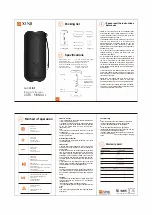
Figure 2.
Speaker Wire Gauge Guide
RWE Rear Wave Enclosure
*
RWE-7C
Stock# FG01643
RWE-8C
Stock# FG01644
6
5
DIRECTED SOUNDFIELD
™
WWW.NILESAUDIO.COM
NILES AUDIO CORPORATION
– 1-800-BUY-HIFI – 1-760-710-0992
Distance from speaker to amplifier
Wire Gauge
Less than 80 feet
16
80 to 200 feet
14
More than 200 feet
12
*
Not for use with SI Speakers
(CONTINUED ON NEXT PAGE)
INSTALLING THE LOUDSPEAKERS
It is often easier to lay the speakers out on the floor and then transfer the
locations to the ceiling with a laser plumb bob. If you are using new construction
brackets, place string across the centers of the bracket to provide a way to align
the bracket to the laser. Remember, you will need 1” to the sides of the mounting
hole for the mounting clamps to secure the speaker to the drywall.
1.
Once you have determined a possible position for the hole cutout, drill a
1/8” pilot hole just barely through the ceiling (1/2” to 5/8” deep in most
homes) in the center of your proposed loudspeaker location.
BE VERY
CAREFUL NOT TO DRILL THROUGH EXISTING WIRES, PIPES, OR
STRUCTURE. IF YOU FEEL ANY EXTRA RESISTANCE AS YOU ARE
DRILLING, STOP.
2.
Cut a foot-long piece of coat hanger. Bend the wire (creating a right
angle) leaving 5-1/2” at one end (this allows for the extra width of the
mounting dogs). Poke the “L-shaped” wire into the pilot hole and turn it
in a complete circle and move it into the ceiling cavity to make sure you
have approximately 6” of depth. If the wire’s movement is obstructed by
anything, fill the hole(s) with spackle and try another location. (If there
is any risk of uninsulated electrical connections within the ceiling area,
use insulating gloves or other materials or consult with an installation
professional before proceeding).
3.
If the coat hanger moves freely in a complete circle and you have
sufficient depth, tape the template to the ceiling and proceed to layout the
other speakers. Once you are comfortable with all speaker locations, use
a pencil to lightly outline the circular template.
4.
Drill the starting point of your cut with a 1/4” bit.
5.
If you are cutting drywall, use a sheetrock or keyhole saw. Cut the hole
with the saw at a 45° angle. That way the drywall section can be replaced
cleanly if there is an unseen obstruction behind the wall.
IMPORTANT: BE
VERY CAREFUL NOT TO SAW THROUGH EXISTING WIRES, PIPES,
OR STRUCTURE. IF YOU FEEL EXTRA RESISTANCE AS YOU ARE
CUTTING, STOP
.
NOTE: DO NOT INSTALL LOUDSPEAKERS BEFORE THE DRYWALL HAS BEEN COMPLETELY
FINISHED AND PAINTED.
INSTALLATION CONSIDERATIONS
CONTINUED
If you are going to use the optional
Niles Rear Wave Enclosure, you will
need an additional 2” of depth and
10” clearance to one side of the
loudspeaker opening.
NOTE: BE VERY CAREFUL WHEN LOCATING
THE SPEAKERS. VERIFY ALL LOCATIONS
ARE CLEAR OF OBSTRUCTIONS BEFORE
CUTTING THE FIRST HOLE.
Each speaker requires two-conductor wiring of sufficient gauge. The gauge
depends on the length of the wire. For recommendations, please refer to (
Figure 2
).
(Stereo Input loudspeakers require four-conductor wiring).
When running loudspeaker wire inside walls or ceilings, use special jacketed
cable (CL-2 or CL-3 rating) to protect the wire and for fire prevention. In some
municipalities, conduit is required. For a trouble-free installation, low voltage wire
such as loudspeaker wire must be in accordance with the National Electrical Code
and any applicable provisions of the local building code. If you are unsure of the
correct installation techniques, wire jacket, or type of conduit to use, consult a
professional audio/video installer, building contractor, or the local building and
inspection department.



























